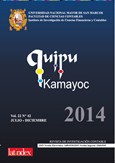AN INTERNATIONAL TAXATION AND AGREEMENTS TO AVOID DOUBLE IMPOSITION
DOI:
https://doi.org/10.15381/quipu.v22i42.11060Keywords:
Tariff barriers, international treaties, taxes, macroeconomic policies, international juridical double taxation, investmentAbstract
The Peru, develops from about 20 years ago macroeco-nomic policy of opening up to international capital, the export of primary products and the promotion of goods subject to a production process that will generate an exportable and competitive value added in the world market. In this context, is a “state policy” subscription “international agreements” that allow us to complement our macroeconomic policies and agree with other countries, and the study, assessment and resolution of their tax effects, in the search for legal certainty to foreign investment and competitiveness of our value-added production, looking at the world as a target.This work analyzes and explains the causes of interna-tional juridical double taxation, which originated in their tax effects corrective established in CDI. Because of this, we apply ourselves the analysis and comments on the purpose and scope of the framework agree-ments to avoid double taxation, our country has been used as prototypes to suit, negotiate and eventually sign agreements with third countries. The Framework Convention’s used by our country is the OECD Model (Organization for Economic Cooperation and De-velopment), an agency of the so-called “Group 20”, where the main countries in wich the world is found. The second framework convention is that developed by the United Nations. Both “framework agreements” have different scopes, they also analyzed, while using different criteria to determine the country to which it falls to tax income.
Downloads
Downloads
Published
Issue
Section
License
Copyright (c) 2014 Adolfo Santa Cruz Miranda

This work is licensed under a Creative Commons Attribution-NonCommercial-ShareAlike 4.0 International License.
AUTHORS RETAIN THEIR RIGHTS:
a. Authors retain their trade mark rights and patent, and also on any process or procedure described in the article.
b. Authors retain their right to share, copy, distribute, perform and publicly communicate their article (eg, to place their article in an institutional repository or publish it in a book), with an acknowledgment of its initial publication in Quipukamayoc .
c. Authors retain theirs right to make a subsequent publication of their work, to use the article or any part thereof (eg a compilation of his papers, lecture notes, thesis, or a book), always indicating the source of publication (the originator of the work, journal, volume, number and date).






